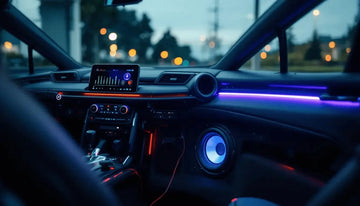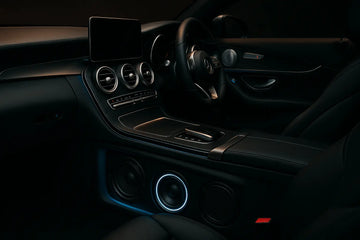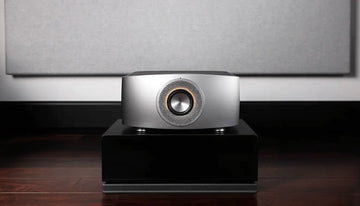Car Tweeters
Related Collections:
Featured Products
Mirus M.75 20mm Titanium Tweeter Pair
Hybrid Audio Imagine Series Tweeters
Xcelsus XPLT28W – PRIMUM SERIES SQL WAVEGUIDE TWEETER
Hybrid Audio Legatia X1 Tweeters - Silver | Previous Display
Dynaudio Esotec MD 102 Soft Dome Tweeter - Pair
Xcelsus XXT30 – Competition Series 30mm Tweeter
Xcelsus XXT30W – Competition Series 30mm WaveGuide Tweeter
XCELSUS XUST30W SQL Waveguide Tweeter - Previous Display
Xcelsus XXT30W – Previous Demo
Dynaudio Esotec MD 102 Tweeters | Previous Display
Rainbow ML-TW16s AD/A6 Matrix Line 16mm Silk Dome Tweeter for Audi
The Ultimate Guide to High-Performance Tweeters

If you've ever been captivated by the crisp crash of a cymbal, the subtle breath of a vocalist, or the delicate shimmer of a violin, you have a high-quality tweeter to thank. Tweeters are specialized drivers within a speaker system, dedicated to reproducing the high-frequency sounds that bring music to life. While larger drivers handle the bass and midrange, the tweeter provides the sparkle, clarity, and sense of space in your audio. For a discerning listener, choosing the right tweeters isn't just an upgrade—it's a transformation. This guide explores their crucial role, explains why an upgrade is worthwhile, and shows you how to select the perfect pair to unlock your audio system's full potential.
Understanding the Role of Tweeters in Your Audio System
A tweeter's primary tweeter function is to convert an electrical audio signal into high-frequency sound waves, typically covering a range from 2,000 Hz to 20,000 Hz and beyond. Think of your speaker system as a team of specialists: the woofer is the powerhouse for deep bass, while the midrange driver covers core sounds like voices and most instruments. The tweeter, however, is the finesse player. It handles the upper octaves containing the harmonics and overtones that give instruments their unique character and texture. Without effective tweeters, music sounds muffled, dull, and lifeless.
Beyond just producing high notes, tweeters are essential for achieving exceptional sound clarity and creating a convincing three-dimensional soundstage. High frequencies are very directional, so tweeter quality and placement directly impact sonic imaging—your ability to perceive the precise location of instruments and voices in a recording. A great set of tweeters creates a wide, deep, and stable soundstage, making it feel as if the performers are in the room with you. This directional nature explains why the design of car audio tweeters, often mounted on A-pillars or the dashboard, differs from home audio tweeters, which are integrated into a cabinet for optimal dispersion. Each environment requires a unique approach to directing these critical high frequencies toward the listener for maximum impact.
Why Consider Upgrading to New Tweeters?
For many audio enthusiasts, the path to sonic perfection often leads to one of the most impactful upgrades available: installing new tweeters. Stock tweeters, whether in a car or a factory-built home speaker, are frequently a compromise, designed to meet a budget rather than deliver peak performance. Upgrading them is a classic strategy for significant audio system enhancement. The most common motivation is to achieve a dramatic leap in improved sound quality. Factory components can sound harsh, lack detail, or offer poor dispersion, leaving your music feeling flat. If you want to upgrade car tweeters or replace home tweeters that are old, damaged, or underwhelming, a new set can make a night-and-day difference.
The benefits are immediate and profound. High-quality tweeters offer vastly improved clarity, revealing subtle nuances in your favorite tracks that were previously buried. You'll hear the delicate decay of a hi-hat, the texture in a singer's voice, and the airy atmosphere of a live recording. Superior tweeters also provide a wider, more accurate dispersion pattern, which distributes sound more evenly throughout the listening area. This creates a larger "sweet spot," so you don't have to sit in one perfect position to enjoy an immersive experience. Modern tweeters also boast a better transient response—the ability to start and stop instantly—which translates to sharper, cleaner, and more realistic sound, free of the "smearing" or distortion common in lesser designs. By carefully integrating new tweeter technology, you can elevate your entire system, ensuring every component works in harmony to produce a truly breathtaking performance.
Key Factors for Choosing the Right Tweeters
The process of choosing tweeters involves more than just picking the most expensive model. To achieve sonic synergy, you must match the tweeter's technical specifications to your existing system. Paying close attention to these details ensures both compatibility and optimal performance.
-
Impedance: Measured in ohms (Ω), impedance is the electrical resistance a tweeter presents to your amplifier. Proper impedance matching is crucial. Most car audio tweeters are 4 ohms, while home audio models are often 6 or 8 ohms. A mismatch can overwork your amplifier or even cause damage, so always ensure the tweeter's impedance is compatible with your amplifier's design.
-
Power Handling (RMS vs. Peak): This specification, measured in watts, indicates how much power a tweeter can handle safely. RMS (Root Mean Square) power, the continuous power it can manage, is the most important figure. Peak power is the maximum it can handle in brief bursts. Your tweeter's RMS rating should align with your amplifier's output to prevent distortion from underpowering or damage from overpowering.
-
Sensitivity: Rated in decibels (dB), sensitivity measures how efficiently a tweeter converts power into sound. A higher sensitivity rating means the tweeter will play louder with less power. This is vital for matching the output level of your tweeters with your midrange drivers and woofers to create a balanced, cohesive sound.
-
Frequency Response: This indicates the range of frequencies the tweeter can reproduce (e.g., 2,500 Hz - 22,000 Hz). Look for a smooth and extended response curve. A wider range isn't always better if it's not smooth; peaks or dips in the response can cause harshness or a lack of detail.
-
Mounting Depth and Size: A practical but critical consideration. Before you buy, measure the available space. This is especially important for in-car installations, where mounting depth and cutout diameter are often tightly constrained.
Beyond these core tweeter specifications, consider your personal listening preferences. Do you prefer a warm, smooth sound or a hyper-detailed, analytical presentation? The type of music you enjoy can also guide your choice. Ultimately, the best tweeter not only integrates perfectly with your amplifier and other speakers but also complements your unique taste in sound.
Exploring Different Types of Tweeters and Their Characteristics
The world of high-frequency drivers is diverse, with each design offering a distinct sonic signature. Understanding the different types of tweeters is key to finding the sound that resonates with you. The most common and widely used are dome tweeters, which are broadly categorized by their material.
-
Soft Dome Tweeters: Typically made from treated silk or other textiles, soft domes are prized for their smooth, warm, and natural sound. They exhibit excellent damping, which helps control unwanted resonances and results in a less fatiguing listening experience. They are a fantastic all-around choice, particularly for vocals and acoustic music.
-
Hard Dome Tweeters: Constructed from rigid materials like aluminum, titanium, beryllium, or ceramic, hard domes are known for their exceptional stiffness and low mass. This allows them to reproduce sound with incredible speed, detail, and precision. The trade-off is that lower-quality designs can sometimes sound "bright" or metallic, but a well-engineered metal dome tweeter delivers unparalleled crispness and clarity. The classic soft dome vs metal dome debate often comes down to personal preference between warmth and detail.
Beyond the ubiquitous dome, several other designs cater to more specific applications and audiophile tastes:
-
Horn Tweeters: These pair a driver with a flared horn to dramatically increase efficiency and control dispersion. They can play extremely loud with very little power, making them ideal for large home theaters and professional audio. Their sound is dynamic and forward, though they can be "shouty" if not implemented correctly.
-
Ribbon Tweeters: True ribbon tweeters use an ultra-thin, lightweight aluminum ribbon suspended in a powerful magnetic field. This design has almost no mass, allowing for an incredibly fast transient response. The result is an airy, transparent, and exceptionally detailed high-frequency presentation, often found in high-end audiophile speakers.
-
Planar Magnetic Tweeters: Similar in principle to ribbons, planar tweeters use a flat, thin diaphragm with a voice coil circuit etched onto its surface. They offer many of the benefits of ribbons—namely detail and speed—but are typically more robust and can handle more power, providing a wonderfully natural and uncolored sound.
Maximizing Your Sound: Installation and Integration Tips
Purchasing high-quality tweeters is only half the battle; proper installation and integration are what unlock their true performance. Even the best tweeters will sound poor if installed incorrectly. The most critical factor in installing tweeters is placement. Because high frequencies are so directional, where you position them has a massive effect on the soundstage and imaging. For car tweeter placement, mounting them on the A-pillars or sail panels and aiming them toward the listener's head is often ideal. This raises the soundstage to dashboard level and creates a more immersive experience. In a home audio setup, tweeters should ideally be at ear level in your primary listening position.
Equally important is the use of a crossover, an electronic filter that directs specific frequencies to the appropriate driver. It sends high frequencies to the tweeter while blocking damaging low-frequency bass notes. Without a crossover, a tweeter would be destroyed almost instantly. When setting up your system, proper crossover settings are essential. A high-pass filter for the tweeter is typically set between 2,500 Hz and 3,500 Hz to ensure a seamless blend with the midrange driver. Finally, once installed, take time for basic sound tuning. Use your head unit or amplifier's equalizer to make small adjustments. You may need to lower the tweeter's output if it sounds too bright or boost it if it's too subdued. The goal is to achieve a smooth, natural balance across the entire frequency spectrum. For complex active systems or custom fabrication, consider seeking professional installation to guarantee a flawless result.
Elevate Your Listening Experience with Premium Tweeters
As we've explored, the impact of high-quality tweeters on your audio experience cannot be overstated. They are the voice of detail, the source of clarity, and the key to a truly immersive soundstage. From the smooth warmth of a silk dome to the crystalline detail of a ribbon, the right tweeter doesn't just play the high notes—it reveals the soul of the music. Investing in premium tweeters is one of the most rewarding car audio upgrades or home audio enhancements you can make, transforming a good system into a great one.
Whether you're a seasoned audiophile seeking the ultimate in fidelity with audiophile tweeters or an enthusiast looking to bring your factory system to life, the perfect solution awaits. We encourage you to explore our curated selection of top-rated tweeters from the industry's most respected brands. Use the on-page filters to narrow your search by type, impedance, power handling, and more. Each product page provides detailed specifications to help you make an informed decision. Are you ready to hear every last detail you've been missing? Browse our collection of new tweeters and take the first step toward unparalleled sound clarity today.
Car Tweeters
Frequently Asked Questions
What do car tweeters do in an audio system?
What are the different types of car tweeters?
Where should car tweeters be installed?
What materials are car tweeters made of?
What’s the difference between coaxial and component tweeters?
Related Articles

Loudspeakers for Cars: Complete Guide to Upgrading Your Vehicle’s Audio System

Best Car Sub and Speakers for Every Budget in 2025

Best Focused Speaker Technology for Superior Sound Precision














